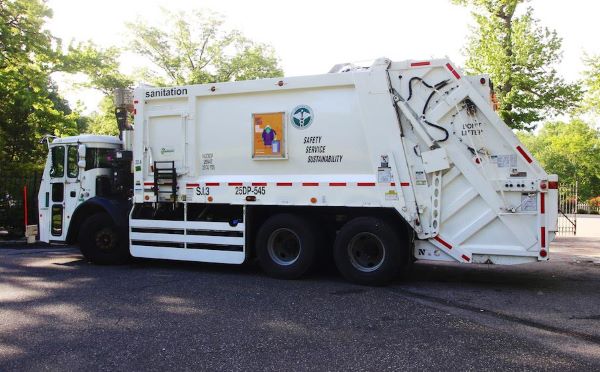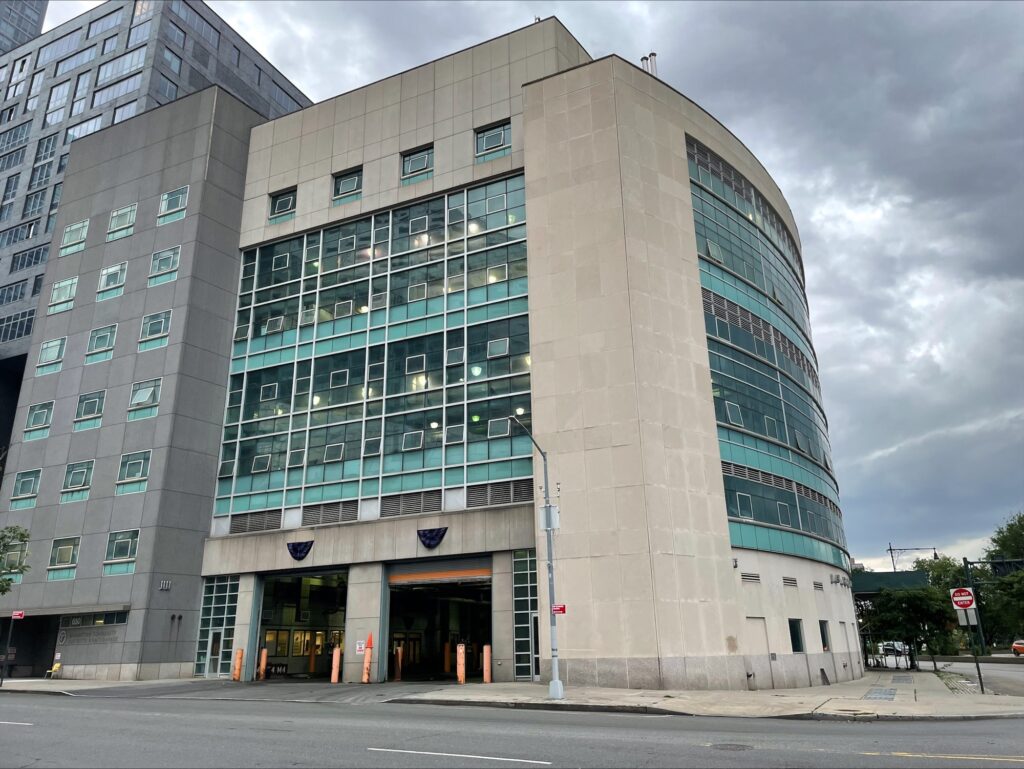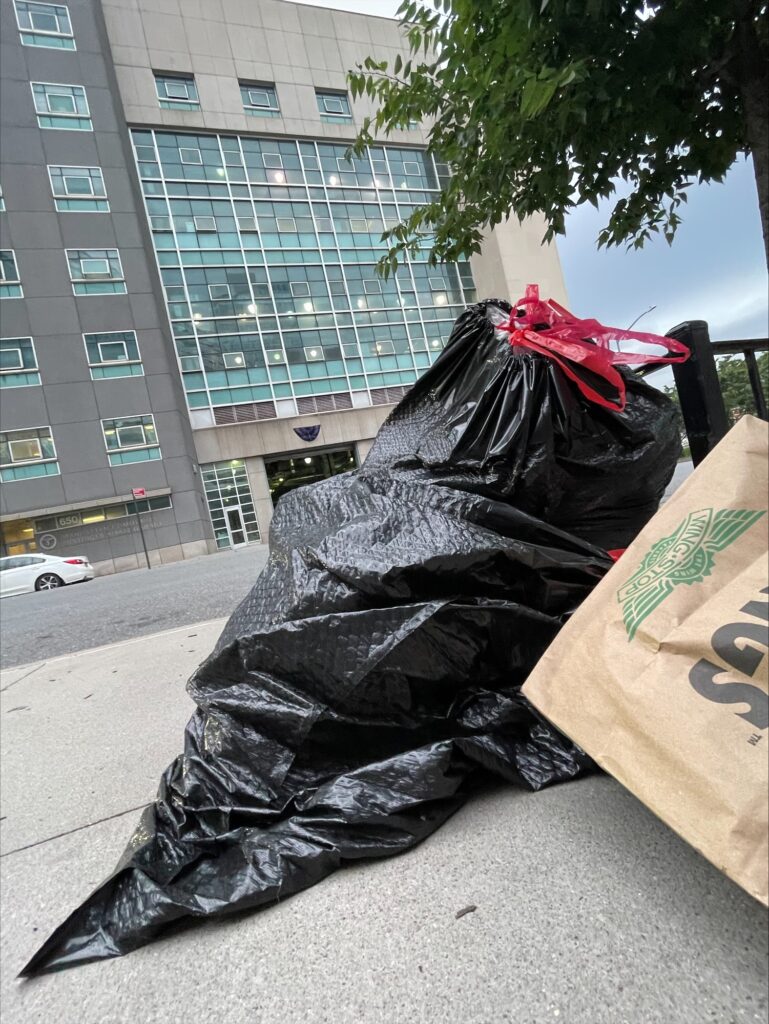Alek Miletic

Credit: NYC Department of Sanitation
It’s a comment New Yorkers hear from tourists, family, and friends who visit: New York City is so dirty! Admittedly, as a native New Yorker, I have become desensitized to the garbage and waste that piles on the public streets and sidewalks. Only when it becomes a nuisance—like hot, smelly garbage in the summer, or the derelict vehicle that hasn’t left its parking spot in years—does it become an issue for me. But for many other New Yorkers, sanitation is a key health, safety, and quality of life issue. And in charge is one key department.
The New York City Department of Sanitation (DSNY) is the largest municipal waste services department in the world. It accounts for 2% of the City’s budget and has a staff of approximately 10,000 workers, placing it among the largest departments in the City. The DSNY is responsible for everything related to sanitation, including waste removal, recycling, composting, removal of derelict vehicles, cleaning vacant lots, and snow removal. It is a very important service.
The DSNY is also down-to-earth. Its social media pages boast tens of thousands of followers and are peppered with a combination of achievements, history, informational facts, and memes. They have not one, but five mascots. The sanitation department’s motto is “New York’s Strongest,” which can be found hashtagged on many posts. Its uniforms are popular streetwear items. DSNY Commissioner Jessica Tisch left an all-time sound bite at a press conference in October 2022 that went viral on social media: “The rats don’t run this city, we do.” The sound bite became an unintentional meme, trending on social media platforms for weeks. This seems to be par for the course; DSNY wants to embrace a “cheeky approach to some of its social media and outreach campaigns.” Not many other sanitation departments can claim an artist-in-residence and an anthropologist-in-residence. But are the social media posts and acclaim frivolous? While the agency’s social media presence is certainly helpful when providing information, it does not equate to better sanitation services, especially for those who need it most.
There are certain circumstances where DSNY reneges on its duty to provide equitable services, especially to minority communities. In places such as East New York (which leads the City in 311 calls to report illegal dumping), or Hollis (which has previously led the City in 311 calls to report illegal dumping), or Bronx Community District 12 (which has the least clean streets in the entire borough), the sanitation needs of these communities are not met while white neighborhoods receive better sanitation services. To put it into perspective, according to the Mayor’s Office of Operations’ Scorecard Inspection program, which measures and reports on street and sidewalk cleanliness across the city’s five boroughs, the streets in Manhattan Community Board 6, which is 76% white, was deemed 100% acceptably clean for January 2023, while 82% of streets in Manhattan Community Board 12, which is 74% Hispanic, were deemed acceptably clean for the same month.
Furthermore, DSNY’s resources are stretched thin, which further exacerbates inequities. In March 2023, Mayor Adams announced that DSNY would be responsible for the enforcement of street vendors. Politicians, street vendors, advocates, and others protested the change. Tasking a sanitation agency with enforcing street vendor rules and regulations – a business that I wrote about in length previously – sends a poor message to the immigrant, minority, and underrepresented communities who rely on the vending industry the most. DSNY is also now responsible for cleaning up highways and graffiti, taking responsibility from the Department of Transportation (DOT) and the Economic Development Corporation (EDC), respectively. Additionally, as part of Mayor Adams’ Program to Eliminate the Gap budget initiative, the Mayor is proposing to reduce the DSNY budget by several millions of dollars, even though capital expenditures have increased relatively consistently since the 1980s. The structure of DSNY also makes effective cleaning difficult. The DSNY has 59 garages throughout the City serving communities across all five boroughs. These garages, also known as districts, cover geographic areas that vary in size, population, land use, and needs. As such, the staffed workforce of these districts varies based on these factors.1 These districts are tasked with cleaning their respective streets of garbage, snow, debris, and other kinds of refuse, which, depending on the size of a district, can be a huge haul. For example, Queens East 13, which straddles the Queens-Nassau County border, totals approximately 12.6 square miles and is the largest district outside Staten Island. Its boundaries are roughly coterminous with Queens CD 13, which is 90% non-White. Given its immense size, Queens East 13 staff and similarly expansive sanitation districts struggle to efficiently clear streets. Snow removal in Queens has been a constant problem, as have vacant lots and derelict vehicles, more so than in other smaller geographies. Clearly, equity is an existing issue that needs to be addressed. But why do sanitation services matter to urban environments in the first place? Aside from basic services like waste removal, why is equitable sanitation services important?

The exterior of the West 57th Street DSNY garage, credit: Alek Miletic
Sanitation services are essential to a healthy, safe, and vibrant environment. According to the World Health Organization, poor sanitation reduces human well-being and impairs social and economic development due to adverse health impacts such as anxiety, increased risk of sexual assault, and lost opportunities for education and work. Poor sanitation services also affect the environment, waterways, property taxes, home values, tourism and businesses, quality of life, and health and safety. This, of course, has negative effects on the built environment. Modern cities in developed parts of the world have largely advanced past this. However, as Robin Nagle, the anthropologist-in-residence for the DSNY and author of Picking Up, writes, “When garbage lingers too long on the streets… city life becomes dangerous in ways not common in the developed world for more than a century.”2
Locally, communities and agencies recognize the effects of good and bad sanitation services. DSNY recognizes that sanitation is important to achieving these goals: it “keeps New York City clean, safe, and healthy by collecting, recycling, and disposing of waste, cleaning streets, attacking the scourge of illegal dumping, and clearing snow and ice.” Ten Community Boards—or roughly one in six of all 59 Community Boards—identified trash removal and cleanliness as one of their three most pressing issues in 2021, greater than the total number of Community Boards in 2020 and 2019. Mayor Adams—who is leading the anti-rat movement—signed legislation in the fall of 2022 that would “reduce rats across New York City and build a cleaner and more welcoming city for all New Yorkers.” Think about your own neighborhood: even those desensitized to refuse on the streets can’t help but notice when it becomes all too egregious.
It is important to note that the criteria for sanitation—or, rather, the perception of what is deemed sanitary—is not uniform across all stakeholders in New York City. That is to say, what one deems a satisfactory level of cleanliness, another may not. New Yorkers have questioned the accuracy of reports showing glowing cleanliness ratings. Even residents of tiny neighborhoods with clean streets have qualms about their unclean streets and sidewalks. “It’s unacceptable when you walk around all across New York City that trash is overflowing from litter baskets. It’s being thrown into the street. This is a real quality of life issue, and it’s a health issue as well because of the abundance of rats that are all over New York City,” said Upper East Side Council Member Julie Menin (her district overlaps with Manhattan Community Board 8, which was 100% clean in 2022).

Garbage in front of the DSNY garage on West 57th Street, credit: Alek Miletic
Community input in City decision-making is an important part of the livability of communities. Responses to needs, improvements, and concerns are better when the City engages with its residents. Sanitation services are no exception, however, this often falls flat. It is incumbent upon the City to listen to community stakeholders to better guide the City, its departments, and its politicians when determining where to allocate sanitation resources. The absence of a community-set rubric to prioritize sanitation efforts further exacerbates inequities in service delivery. Without a consensus at the community level as to what constitutes an acceptable level of cleanliness, the more difficult it becomes to accomplish goals equitably. Data drives policy and decision-making, and without finding ways to incorporate and parse through all data sources, effective sanitation services are impossible. In a 2020 audit, the New York State Comptroller noted that DSNY “did not effectively utilize or share relevant information across its bureaus and divisions” and that “DSNY officials did not analyze readily available data” including 311 data and internal records. According to the audit, DSNY uses the Scorecard Inspection program as the only performance measure, but “does not obtain detailed information… to effectively deploy its resources in responses to Project Scorecard’s findings.” In a follow-up report from 2022, the Comptroller’s office noted that the DSNY failed to implement its four recommendations from two years earlier directly related to data usage and analysis while its four other non-data-related recommendations were implemented.
Sanitation services are clearly essential to urban environments. And it is important for cities to ensure that sanitation services are top-notch. Robin Nagle writes that sanitation is the “most important uniformed force” on the streets of New York City, more important than police and firefighters.3 It is imperative that this most-important civil service succeeds in servicing all New Yorkers. Looking to the future, DSNY needs to achieve a standard well beyond its present operational metrics. For a city that is anticipated to grow past 9 million people by 2050, municipal sanitation services need to grow and improve beginning now.
New York City is in the midst of a robust effort to expand its housing stock. Mayor Eric Adams has pledged 500,000 new housing units over the next decade. Governor Kathy Hochul’s state-wide housing plan calls for downstate municipalities—including New York City—to grow its housing stock by 3% every three years (Governor Hochul’s housing plan was recently killed during budget negotiations, but she has indicated she will continue to pursue it going forward). Taken together, the two plans would entail thousands of new housing units annually. With this projected growth come policy concerns, particularly regarding housing equity. Many, including Brooklyn Borough President Antonio Reynoso, have called for development to occur in wealthier, whiter communities rather than the predominantly Black and brown communities which have borne the brunt of development pressure. Growth and development will require a concomitant refactoring in delivering sanitation services. While today affluent, majority-white communities disproportionately enjoy acceptable levels of municipal sanitation services, it is uncertain even in these communities whether existing sanitation infrastructure could withstand a greater strain on its services through population growth. The growth of New York City’s housing stock and its population are closely related. New York City’s population grew by 7.7% between 2010 and 2020, according to US Census data. However, a closer examination on a micro level reveals how this growth played out unevenly by neighborhood. For instance, Queens Community District 2 (Long Island City, Sunnyside, and Woodside) grew by 21.9% while Queens Community District 13 (Bellaire, Bellerose, Brookville, Cambria Heights, Floral Park, Glen Oaks, Laurelton, New Hyde Park, Queens Village, Rosedale, Springfield Gardens) grew by 5.6%. This pattern was informed by development trends and land use policy: Queens CD 2, which had been drastically upzoned in the 2000s, grew its housing stock by 27.9% whereas Queens CD 13 only grew its housing stock by 4.8%, revealing a close relationship between housing production and population growth.
However, growth in housing development occurs across New York City through different means. While New York City and State expect to increase the number of new housing units in the tens of thousands over the next several years through development, more units would be added through other means outside of new development. In January 2023, the New York City Department of City Planning (DCP) released a comprehensive plan detailing how office-to-housing conversions could reasonably occur. Other measures include legalizing accessory dwelling units (ADUs), providing tax breaks to develop affordable housing, and developing housing on under-utilized NYCHA complexes. And while expanding the housing stock is a necessity, the location of important housing would be located in neighborhoods of color. The majority of illegal (or unaccounted for) ADUs are largely located in neighborhoods of color, and since ADUs are most common on small lots containing single- to three- or four-family homes, it is likely that ADUs would expand in these minority neighborhoods. The majority of NYCHA complexes are also located in neighborhoods of color; places in the South Bronx, East Harlem, Lower East Side, Jamaica, and Brownsville contain a majority of the campuses identified as appropriate for development.
The much-touted plan to convert office space into housing is not only widely-discussed but already in the process of being implemented. As office spaces in New York’s commercial districts (mainly Midtown and Lower Manhattan) are repurposed, refuse produced by the new residential units will add to collection volumes for spaces which had formerly been served by third-party private carters. Evolving residential patterns could pose problems for an agency already struggling to collect waste efficiently; residential garbage collected in 2022 exceeded pre-pandemic levels in every borough except Manhattan. The Community Boards representing the central business districts (CBDs) have consistently enjoyed clean streets, with acceptable streets averaging above 90%. As new residents locate in the CBDs, the expectation of continued cleanliness will persist. Underscoring this expectation are familiar class dynamics: the residential units gained through conversion will be largely market rate. As we have discussed, the expectation of cleanliness is closely related to an affluent demographic. While New York City Council Members have called for more affordable units, one of the first office-to-residential conversions is marketing their apartments for sale starting in excess of one million dollars and rentals starting at $5,500. Deeply affordable units would not be required by zoning. DSNY will be required to reallocate resources to accommodate new residents in areas of new growth. In view of a finite pool of scarce resources, this rejiggering of resources could portend further cuts from communities already underserved, exacerbating existing inequities in sanitation services. This outcome is all too likely should new growth occur without a corresponding increase in funding for key services such as sanitation.
The City needs to understand the implications expanded housing stock will have on sanitation services and plan comprehensively. It is imperative to provide all New Yorkers with safe and healthy communities where proper sanitation services play a key role. The accommodation of sanitation services to new growth can follow several directions. One avenue is a wholesale rearranging and reallocation of DSNY resources. Another is to provide DSNY with more funding and staff to accommodate new growth. No matter which course the City ultimately pursues, it is vital to recognize that the status quo has not worked for poorer communities and communities of color. Proper sanitation services are important for healthy cities. And as the number of New Yorkers increases and housing expands, it is imperative for DSNY to ensure that all New Yorkers receive sanitation services equitably.
Notes
1. Robin Nagle, Picking UP: On the Streets and Behind the Trucks with the Sanitation Workers of New York City (New York City: Farrar, Straus and Giroux, 2014), 14-15.
2. Ibid, 24.
3. Ibid, 24.
Alek Miletic graduated from the Hunter College UPP program with an M.U.P. in December 2020. He is the former Chair of APA-New York Metro chapter’s Student Representative Committee and the former Treasurer of GUPPA (fka GUAPA). He currently works as an environmental planner in New York City.

